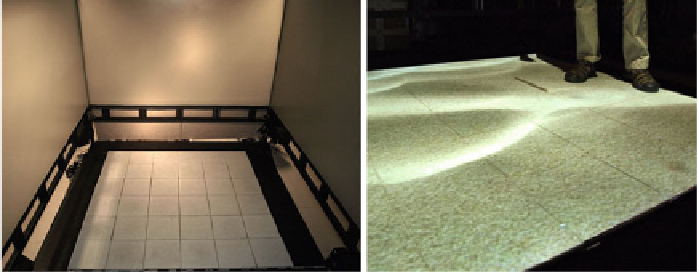Biomedical Engineering Reference
In-Depth Information
Fig. 17.6
The floor interface is situated within an immersive, rear-projected virtual environment
simulator.
Right
visual feedback is provided by
top
-
down
video projection (in the instance shown,
Limited research to date has addressed the usability of floor-based touch inter-
faces. However, since the feet play very different roles in human movement than the
hands do, the extent to which the kinds of techniques that have been adopted for
use with the fingers may be useful for interaction via the feet is questionable and
requires further investigation. For example, when users are standing, there are strong
constraints on the placement of the user's feet, due to the need to maintain stability.
In addition, there are obvious anatomical differences between the hands and feet,
with toes rarely used for prehensile tasks. Nonetheless, human movement research
has studied foot movement control in diverse settings. Visually guided targeting with
the foot has been found to be effectively modeled by a similar version of Fitts' Law
as is employed for modeling hand movements, with an execution time about twice
as long for a similar hand movement [
15
]. However, for many interfaces, usability is
manifestly co-determined by both operator and device limitations (e.g., sensor noise
or inaccuracy), imposing a window on both.
Augsten et al. studied users' performance in selecting keys using a touch-screen
keyboard projected on the floor using precision optical motion capture tracking of
the foot location, a visual crosshair display to indicate the location that was being
pointed to, and a pressure threshold to determine pressing. They found that users
were able to select target buttons (keyboard keys) having one of the three dimensions
1
8 cm with respective error rates of 28.6, 9.5, or 3.0 %.
Sensing accuracy was not the limiting factor in this study, since the motion capture
input provided sub-millimeter accuracy. The authors undertook further studies to
determine users' preferences with respect to the part of the foot to be used as a
pointer for selection, and to determine the extent to which non-intentional stepping
actions could be discriminated from volitional selection operations.
Visell et al. investigated the usability of a floor interface consisting of an array of
instrumented tiles, by assessing users' abilities to select on-screen virtual buttons of
different sizes presented at different distances and directions [
39
]. This example is
described further in the following sections.
.
1
×
1
.
7, 3
.
1
×
3
.
5, or 5
.
3
×
5
.

